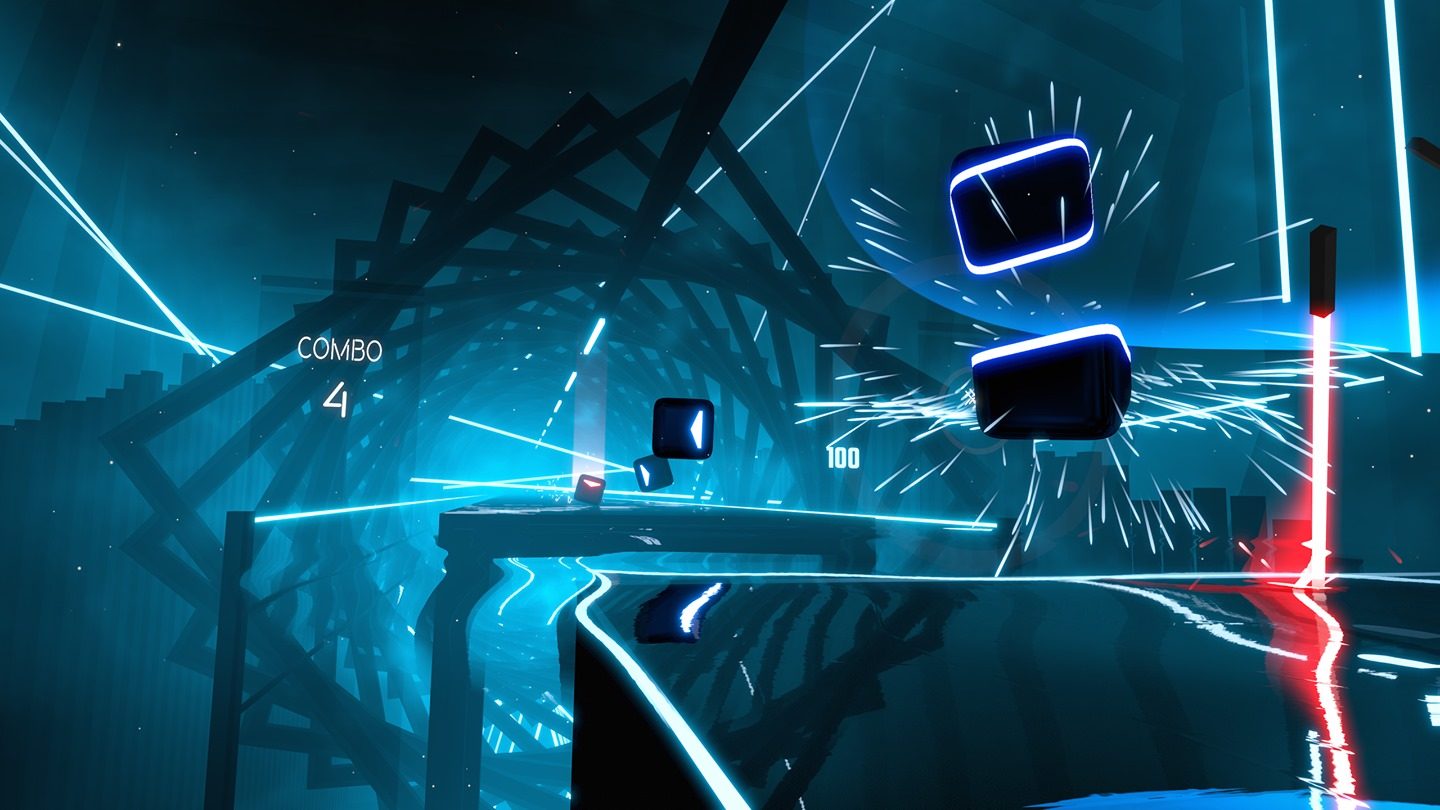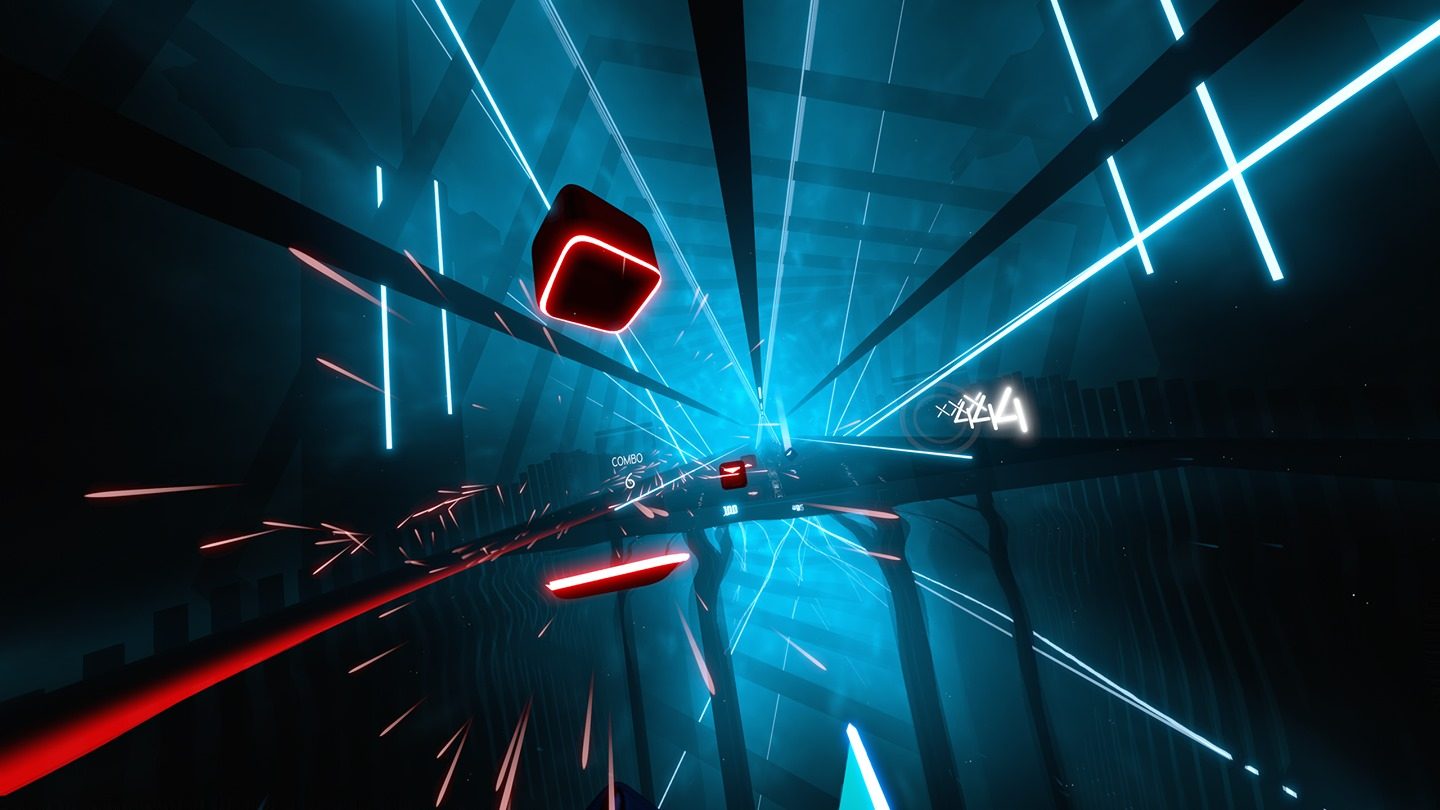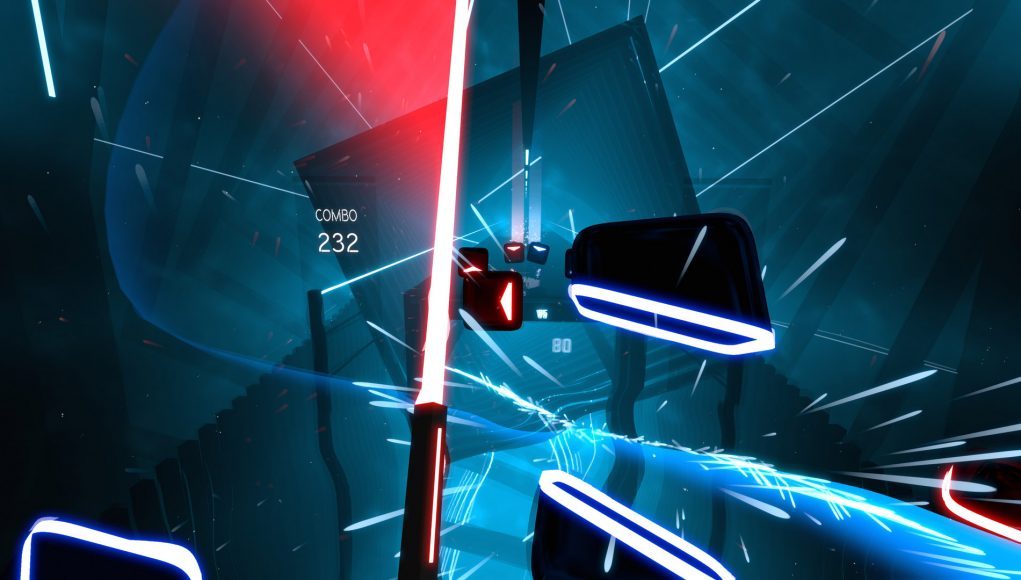Beat Saber is a single player rhythm game in Early Access that puts two lightsabers in your hands and tasks you with one of the funkiest, most stylish Jedi training regimes this side of Alderaan. Slicing incoming blocks to the beat, it’s hard not to dance a little bit too in this intuitive, but ultimately difficult-to-master game that some consider a cross between Guitar Hero and Fruit Ninja.
Beat Saber Details:
Developer: Hyperbolic Magnetism
Available On: Steam (Vive, Rift, Windows VR), Oculus Home (Rift)
Reviewed On: Rift, Vive
Release Date: May 1st, 2018
Note: This game is in Early Access which means the developers have deemed it incomplete and likely to see changes over time. This review is an assessment of the game only at its current Early Access state and will not receive a numerical score.
Gameplay
Unlike 2D rhythm games, which oftentimes make you learn button schemes on proprietary controllers like guitars or dance mats, controls for Beat Saber are comparatively simple; no button presses are required, only a slicing motion using your red or blue lightsaber in the direction indicated on the corresponding block: up, down, left and right.
But just because you implicitly know how to slice something in half with a motion controller doesn’t mean you’ll be a great Beat Saber player right away though. That invariably comes with time once you understand how to ‘read’ the blocks and react, use the beat of the music to sync your moves, and how to slice for maximum efficiency so you can get the full 100 points for an on-beat, accurate cut—essentially making the process of reading and slicing second nature which isn’t something you can develop right away. I certainly don’t have any measurable midichlorians, and I’ve had a fair bit of training with Dance Dance Revolution, Guitar Hero and Fruit Ninja to boot.

A variable difficulty setting allows you to play any of the game’s current selection of 10 songs in easy, normal, hard and expert. The easiest setting is predictably just a few blocks that fly in during the downbeat. Progressing upwards in difficulty, you then encounter barriers that make you shift from left to right, or even duck for fear of losing your all-important combo multiplier. Once you get to expert mode, you’ll have to have that second nature sense, otherwise you’re doomed to see the blocks disappear in front of you and hear the music fade away.
Check out the session captured by mixed reality company LIV to get a good idea of just what to expect on expert mode.
And it’s just about as crazy as it looks. After a few hours with Beat Saber I was reliably hitting an ‘A’ grade on all songs on hard mode, but only passed a few on expert. I obviously haven’t developed the knack for reading and reacting yet, at least not on the level of the person in the video above. Since levels are hand designed and tested, all of them have their own digestible patterns. Almost like a martial arts kata, or a programmed set of moves, you can learn through brute force just like in any rhythm game too.
There are only leaderboards for now—global, player, and Steam friends—although you can create a local, session-based leaderboard in Party Mode so you can keep track of who gets the highest score among a group of friends in the same room. There is also a One-handed Mode which I thought was particularly cool add-on for anyone who may not have the use of two arms.
It’s something you could pitch to almost any VR first-timer to sell them on just how fun and immersive room-scale VR can be, and would easily be the focus of your own Beat Saber party. At only 2-3 minutes per track, it’s simply too easy to pass around too. My wife, who doesn’t gravitate towards VR games in general, has bugged me for the past few days to play—a sign to me that Beat Saber has hit the mark in terms of intuitive, immersive and ultimately really fun gameplay.
Immersion
For now, Beat Saber offers a single futuristic space with neon lighting and twisting architecture, something that feels like it’s from a long time ago, in an EDM concert far away. It’s a cool environment that certainly sets the stage for an equally sci-fi activity, although at the moment the game would admittedly benefit from multiple areas if only to showcase more music genres. At this point, Beat Saber is stocked with 10 songs created by Czech composer Jaroslav Beck. There are a few styles of music including drum & bass, hip hop, and rock, but all more or less adopt a very EDM speed ranging between 90-166 BPM. Variability there too will be key to the game’s continued success.
Nuts and bolts-wise, the game’s haptics give you the sense that your lightsabers have a definite shape as they make contact with barriers, blocks and even themselves. The faint buzz isn’t overwhelming either, and mentally helps you register hits instead of relying solely on the visual markers when you execute a good cut.

Importantly, Beat Saber doesn’t overcomplicate the visual field by cluttering it with scores, or any other obnoxious UI. There’s a score counter at your feet and a pretty demure written message and audio warning when you miss a block, or hit it incorrectly, but nothing that might take away from the singular task of slicing blocks.
A well-designed and frenetic game like Beat Saber is a good recipe for forgetting you’re in your living room dancing in your underwear, so make sure to clear the ares (and shut the blinds). As with any game that gets you up and moving, you’re also bound to get your heart rate up and sweat a bit.
Comfort
Since there is artificial locomotion at all, Beat Saber is among some of the most comfortable VR games you can play in terms of motion sickness. It can be physically tiring, but I never experienced any joint fatigue that I typically get in games that reward fast behavior, which if unchecked, can lead to hyper-extensions of the elbow joint.
Summary
Beat Saber is stylish, fun and hits all the right notes for a VR-native rhythm game. In its Early Access state, it’s missing out on some variability when it comes to songs and visuals, but lays the foundation for a game that has the potential to charm a pretty wide audience. Gameplay is intuitive, but also difficult to master, making it a title worth revisiting, and passing around to anyone regardless of age or gaming background.
Note: This game is in Early Access which means the developers have deemed it incomplete and likely to see changes over time. This review is an assessment of the game only at its current Early Access state and will not receive a numerical score.







